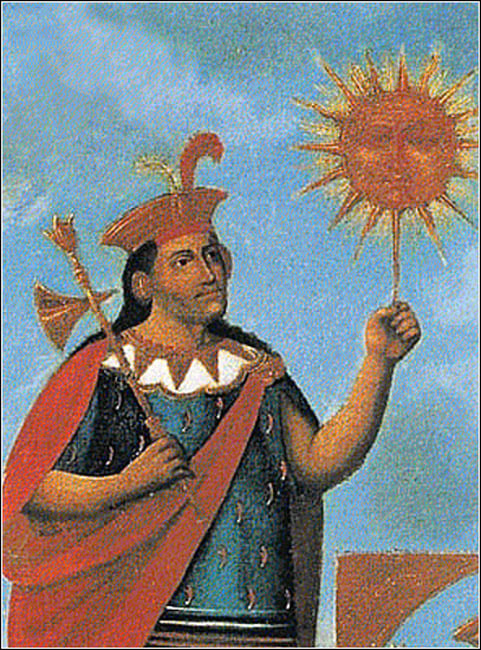
Viracocha's Astronomical Creation Engine
3,500 years ago, the southern shores of Lake Titicaca, situated in La Paz, Bolivia, were inhabited by the Tiwanaku culture who built stone super-structures such as; the Akapana, Pumapunku, the Kalasasaya and the Semi-Subterranean Temple. The Inca civilization later dominated the Peruvian Andes between the 13th and 16th century and inherited Tiwanaku cosmology, religion and traditions.

South shores of Lake Titicaca (Diego Delso, delso.photo/CC BY-SA 4.0)
Supreme Creator and The First Man
According to a creation myth recorded by 16th century Spanish chronicler Juan Diez de Betanzos, the Inca’s supreme-creator god Con Tici Viracocha rose from Lake Titicaca “during the time of darkness to bring forth light.” Most often described as an old man with fair-skin and a beard, wearing a long robe and carrying a staff and a book, after crafting the sun, moon, planets and stars from islands on Lake Titicaca he created “a race of brainless giants from stone,” which he destroyed with a great flood. Viracocha then used clay and successfully forged the first man, Manco Capac (meaning: splendid foundation) the son of Inti the son god, and his sister Mama Uqllu, which means "mother fertility".

Manco Capac, detail of ‘Genealogy of the Incas’ (Public Domain)
Walking north from Lake Titicaca with a golden staff called ‘tapac-yauri’ when they reached the Cusco Valley the golden staff sank into the ground, founding the Inca civilization, the royal blood line of Sapo Incas, and the center of what would later become the Coricancha Temple of the Sun, a gold-plated super-structure of worship.

Depiction of Inca emperor Pachacuti worshipping Inti in the Coricancha (Public Domain)
Having given his people language, emotions, civilization, agriculture and the arts, Viracocha then created all the animals and finally set the universe in motion before “journeying to the north-west, teaching humanity and the arts before he walked across the Pacific Ocean, promising one day to return to Lake Titicaca.”
Nine generations after Manco Capac founded Cusco with his golden staff, chronicler Garcilaso de la Vega tells us the 9th Inca ruler Sapa Inca Pachacuti created the Inti Raymi (Quechua for "sun festival”) to celebrate the winter solstice, the shortest day of the year, and new year in the Andes of the Southern Hemisphere. The Inti Raymi honored the sun god Inti, one of the most venerated deities in Inca religion, and the ceremony also honored the special day upon which Viracocha created Manco Inca, the father of the royal Inca bloodline.

Inti Raymi (Festival of the Sun) at Sacsayhuaman,Cusco (Cyntia Motta/CC BY-SA 3.0)
In all of the numerous versions of the Inca creation myth, Viracocha’s creation event occurred on the June solstice, when the agricultural, civic and ceremonial calendars came to an annual close — the New Year. In Peru, the June solstice sun rises at 65° east of north and sets at 295° north west. Local variations to these astronomical angles were made to account for differing altitudes and obstructions on the horizon.
On this special date, the sun was believed to calibrate, and power-up, the national ceke line system of 41 invisible, long-distance alignments which emanated from the Coricancha Temple of the Sun in Cusco, and across the Inca empire. This radial matrix of alignments was pinned onto the landscape with sacred sites called huacas. Perceived as flowing with male and female creation energy, the ceke lines not only united the spiritual focus of a nation but they also served as an accurate calendrical and time device, and the knowledge of how to use or read such a semi-mythical machine was highly-guarded by the high priests of the Coricancha.
The Inca’s Solar-Earth Empire
Andean cosmovision is a term used to describe how ancient Andean cultures viewed time and space. Inca people nurtured a complex polytheistic and animistic world view in which all agricultural, ritual and ceremonial calendars began/ended on the June solstice. The sunlight and the resulting shadows observed at the solstice sunrise were highly spiritualized, and to fulfil their full sacred potential they were extended across landscapes by teams of specialist astronomer-priests, highly-trained in the sacred crafts of measuring time and distance.
This FREE PREVIEW is just a taste of the great benefits you can find at Ancient Origins Premium.
Join us there ( with easy, instant access ) and reap the rewards: NO MORE ADS, NO POPUPS, GET FREE eBOOKS, JOIN WEBINARS, EXPEDITIONS, WIN GIFT GIVEAWAYS & more!
- The Golden Stick: Cuzco’s Divine Foundation Myth and The Scientific Connections
- Ancient Sacred Sites Triangularly Aligned by the Footsteps of the Gods
- Sex Symbols of the Ancient World: Top Ten Sexually Explicit Caves, Mountains, Temples and Artifacts
Ashley Cowie is a researcher, explorer, film-maker and blogger about lost cultures and kingdoms, ancient crafts and arts, the origins of legends and myths, architecture, iconography, artifacts and treasures. He is also author of A Twist in Time: How The Rope Age Made Mankind | Visit AshleyCowie.com
--
Top Image: The night sky (E SO/H.H. Heyer/CC BY 4.0), Night display at an ceremony of Inca Heritage at the Pachacama Complex (CC BY 2.0); Deriv.
By Ashley Cowie
















